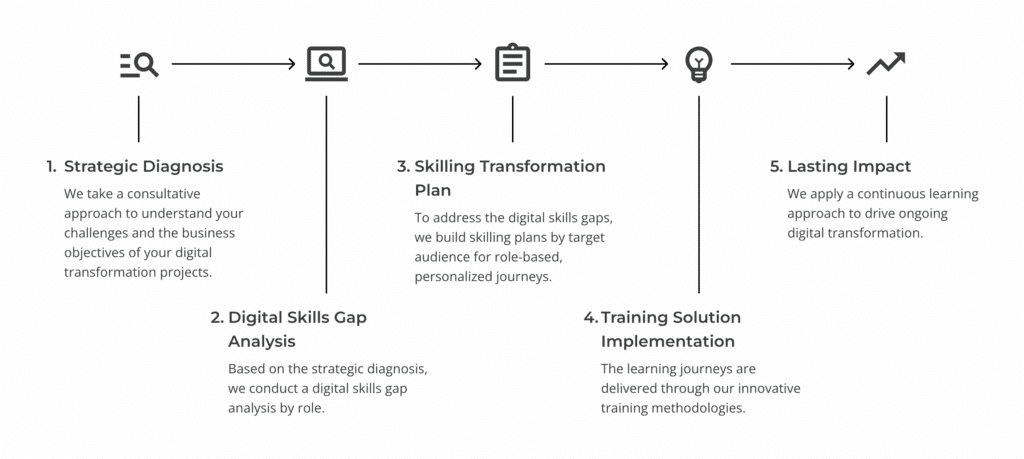The transition to digital technologies has been high paced for many organizations and, with the recent innovation in spaces such as artificial intelligence, it is inevitable that companies are going to need to adapt further. However, navigating through such a vast field of technological advancements, whilst also managing an organization and its employees can make it extremely difficult to ensure new processes are effectively implemented.
Fortunately, the use of an established Digital Transformation Framework can help organizations to execute their digital transformation more effectively, by aligning digital initiatives with specific businesses objectives and outlining a realistic implementation roadmap that ensures technologies are successfully onboarded.
This article aims to help organizations understand digital transformation frameworks further and how they can be used to support a successful digital transformation.
What is a Digital Transformation Framework?
A digital transformation framework is a structured approach or model that organizations use to plan, implement, and manage the use digital technologies that fundamentally improve business models, processes, customer value, and the achievement of organizational objectives. It provides a roadmap for organizations to navigate the complex process of digital transformation and adapt this to suit their workforce and overall needs.
Why Do Organizations Need a Digital Transformation Framework?
Digital transformation frameworks provide a number of organizational benefits, that may help to utilize areas that may not have been considered if the framework was not used. These areas have been outlined below.
Strategic Alignment
A digital transformation framework helps to ensure that the digital initiatives used are aligned with the organization’s overall strategic goals. This helps to make certain that investments into the digital transformation for the organization are directed toward achieving specific business objectives rather than just embracing the latest digital trend, helping to increase the value of the transformation.
Additionally, digital projects that do not follow a framework may lack direction and coherence, potentially leading to further wasted resources and missed opportunities for strategic advancement.
Roadmap for Change
The application of a digital transformation framework can also serve as a roadmap for change within an organization. This is because it outlines the sequence of clear steps, milestones, and timelines required to achieve digital transformation goals. This provides clarity to all stakeholders and ensures a realistic and achievable on-boarding of the new software and processes, including the relevant training and reskilling programs. Without a clear roadmap, organizations can often struggle to provide successful digital implementation programs for employees, leading to a lack of organizational change and an ineffective digital transformation.
Change Management
As part of its effectiveness for organizational change, a digital transformation framework also includes initiatives on how change can be managed during an organization’s digital transformation. A digital transformation often presents significant changes in processes and organizational culture, which, understandably, can lead to internal resistance and challenges to embracing chance.
A digital transformation framework provides guidance on how changes can be communicated effectively to employees, how new technologies can be used, and how to address resistance to change. Without a robust digital transformation framework, organizations risk encountering internal resistance and are likely to find difficulties in adapting to the new digital systems put in place.
Resource Allocation
Effective resource allocation can be the deciding factor between the success or the failure of a full digital transformation project. Without a framework, organizations may struggle to allocate resources optimally, leading to budget overruns, delays and potentially the cancellation of digital transformation efforts.
A digital transformation framework helps organizations to better allocate budget and human resources toward the most critical areas that require change in your organization, which helps to reduce wasted resources and improve the effectiveness of your digital transformation.
Performance Measurement
Measuring the performance of your digital transformation is vital for making data-driven decisions and ensuring that the digital initiatives included deliver value. A comprehensive digital transformation framework will include key performance indicators (KPIs) and other metrics for your organization to monitor, which will help your organization to assess the performance of your transformation efforts. Additionally, monitoring these metrics will allow organizations to gauge the return on investment or internal value of their new digital processes and adjust when needed.
Without a digital transformation framework, organizations may fail to find a standardized approach to performance measurement, making it harder for business leaders to evaluate the effectiveness of their digital initiatives.
What Features Does a Good Digital Transformation Framework Have?
Improves Business Processes Across the Entire Organization
A strong digital transformation framework will help to optimize key business processes throughout the organization. A good digital transformation framework includes methodologies and tools for assessing current processes, enabling organizations to identify bottlenecks, and opportunities for improvement across the company. This makes certain that digital transformation initiatives are not isolated to specific areas within your organization, but also have a holistic impact on your company’s operations as a whole.
Includes Power Skills
All strong digital transformation frameworks should recognize the importance of “power skills” alongside technical skills. Power skills encompass soft skills such as leadership, communication, problem-solving, and adaptability, which continue to be crucial for all organizational talent. They are essential for fostering collaboration, guiding teams through change and effectively utilizing new technology, which are all skills vital for a successful digital transformation.
To ensure power skills are present in your organization, a strong digital transformation framework should also offer resources and training to help employees develop and master power skills for self and organizational development.
Includes Tech Skills that Meet Customer Expectations
Each organization will require a bespoke digital transformation plan that aligns with their specific digital initiatives. Therefore, a strong digital transformation framework will also incorporate strategy for identifying the specific technologies that align with not only the business model and the internal expectations, but also the customer expectations. The framework will support your organization continue to adapt its digital processes and application to support the evolving needs and preferences of customers.
Instills a Culture of Continuous Learning and Improvement
Aside from encouraging a culture of change, another key feature of an effective digital transformation framework is its emphasis on creating a culture of continuous learning and improvement.
A proficient framework should provide foundations for ongoing training, knowledge sharing, and feedback loops to encourage a culture of continuous growth and to help employees understand the value of continuous learning.
The Digital Transformation Framework at Elev8
Being at the forefront of digital transformation, Elev8 have provided successful digital transformation strategies for over 5000 enterprises. We know that success in the digital realm requires more than just expertise in tech; the right blend of tech, power, and business skills is what drives digital innovation within an organization.

Role-focused Transformations
Our digital transformation framework can be adapted to equip your leadership and management teams with the skills they need to drive innovation and digital transformation within your organization through a range of meticulous digital acceleration, adoption and talent onboarding solutions.

7 Steps To Developing an Efficient Digital Transformation Strategy
Assess Your Current State and Define Your Objectives
The first step to developing an efficient, digital transformation strategy framework is to conduct a comprehensive assessment of your organization’s existing digital capabilities, such as the systems, platforms and other digital initiatives it uses. Once a thorough analysis has been conducted, identify the strengths, weaknesses, opportunities, and threats within your existing systems. This can then be used to define clear and measurable objectives that align with your organization’s overall aims for its digital transformation.
Involve and Engage Stakeholders
All successful transformations within business require the active involvement and engagement of key stakeholders across the organization. This includes executives, managers, employees, and even customers or partners; it’s important to consider all parties who may be affected by the transformation. By engaging all relevant parties early within your transformational process, it makes it easier to gather insights, build support, and ensure that their perspectives are considered when shaping the business strategy itself.
Conduct Research into the Future Digital Space
If your organization is considering a digital transformation, it’s likely you already have an idea of which technologies your business needs. However, it’s crucial that extensive research is carried out beforehand on emerging technologies, the latest industry trends, and the evolving digital landscape. By conducting thorough research beforehand, you’ll understand how digital technology advancements may potentially impact your industry and organization. This will help you make informed decisions, anticipate future opportunities and challenges and avoid any changes to the scope of your digital transformation.
Prioritize High-Impact Areas
The rapid advancement of digital technologies has led to a plethora of opportunities for digital advancement. Although a lot of these areas may seem appealing for your organization, it’s important to identify and prioritize high-impact areas where digital transformation will make a significant difference in achieving your business objectives, instead of on-boarding technologies just for the sake of staying on trend.
Take time to consider what the benefits of certain technologies will be for your organization – this may include things such as improving customer experience, streamlining operations, driving revenue growth, or enhancing competitive advantage. The prioritization of these areas will ensure that the right allocation of resources are provided to initiatives with the most potential for organizational success.
Develop a Roadmap
As included within all effective digital transformation frameworks, a well-defined roadmap is a critical component of your digital transformation strategy. It’s important to make sure your roadmap provides a clear overview of the expectations and the responsibilities of team members throughout the digital transformation journey. Additionally, consider making your roadmap easily adaptable; circumstances can change and opportunities for improvement may arise, which you wouldn’t want to miss out on.
Allocate Resources
For a company-wide transformation to be valuable, it’s crucial resources are strategically allocated to ensure short-term and long-term goals are achieved. Key resources to consider are your budget, technology, talent, and time you’ll need to support your digital transformation initiatives. Moreover, it’s important to also that is room within the project scope for the ongoing monitoring and adjustment of resources as needed.
Foster a Culture of Digital Innovation
To build a culture of innovation, it’s important that time is taken to teach employees the values and importance of digital innovation. Focus on actively encouraging and empowering employees to embrace digital tools and methodologies, experiment with new technologies, and contribute innovative ideas.
By creating a supportive environment that values learning and continuous improvement, employees will feel more confident contributing to discussions surrounding technological advancement. Remember, leadership plays a crucial role in fostering this culture by setting an example, so it’s important that all leadership/management teams are aligned on building this culture within the organization.
Your Digital Transformation Process, Powered by Elev8
The idea of a digital transformation prevails as a key point of interest for many organizations. The future demands a blend of critical thinking, problem-solving and digitally literate qualities within the workforce to tackle the ever-evolving digital space and the challenges that are uncovered.
When implemented correctly, a digital transformation has the potential to transform the digital disruption into a competitive advantage and create a lasting impact within your organization.
Are you ready to digitally transform your organization? Contact us today to discuss how our digital transformation framework can be adapted to suit your needs.




